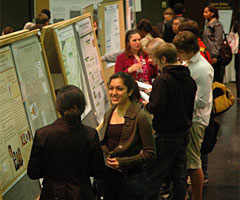Research, Scholarship and Creativity
Virtual dance spaces. Why people drink diet coke, fail to lose weight and continue buying it. The implications and effects of male breast cancer on survivors. The reduction of cosmic radiation among NASA. astronauts.
This is just a sampling of the topics to be presented at two upcoming UMBC events that celebrate the research and creative achievements of undergraduate and graduate students.
The 14th annual Undergraduate Research and Creative Achievement Day (URCAD) will be held Wednesday, April 28, followed by the 32nd annual Graduate Research Conference (GRC) on Friday, April 30. Both events recognize the research and creative achievements of undergraduate and graduate students by displaying their innovative and groundbreaking work.
Presented by the Office of Undergraduate Education, URCAD gives students valuable experience preparing for graduate school or future careers, and in many cases, competitive grants of up to $1,500 over an academic year to support selected work. More than 200 presentations or performances are scheduled for this year’s event.
“URCAD is truly a celebration of the robust quest for research and creative achievement that is a hallmark of UMBC,” said Joseph Morin, chair of the URCAD Faculty Committee and associate chair and lecturer of music. “All disciplines are represented including the virtual world where, this year, visitors can travel as an avatar through student-designed art galleries. The size, scope and depth of URCAD makes it clear that UMBC provides ‘outstanding opportunities for undergraduate research and creative projects’ as reported by U.S. News & World Report.”
Sponsored by the Graduate Student Association, the GRC on Friday, April 30, will include more than 110 graduate student oral and poster presentations ranging from gerontology to molecular biology. This year’s GRC keynote speaker is Tamara Lewis ’92, psychology, a member of the UMBC Alumni Board. Lewis is an education program specialist at the Maryland State Department of Education in the Division of Accountability and Assessment.
“With more than 110 presentations, graduate students are eager to share their research with their colleagues, faculty members and alumni,” said Jenness Hall, executive director of the GSA. “It is a wonderful day to show off these bright, articulate researchers.”
Selected highlights of 2010 URCAD and GRC presentations and performances include:
- Antioxidants, such as Vitamin C, minimize and prevent the effects of Alzheimer’s disease, cancer and heart disease. However, Phillip Kang ’11, chemical engineering, has found that current methods of determining antioxidant amounts in supplements and food may not reflect bodily responses. His research aims to better categorize antioxidants, allowing diseases to be treated in a more specific and effective manner.
- Cara Gibson ’10, American studies, examined the way Diet Coke is marketed as a “health” product in an increasingly unhealthy society. Focusing on advertisements, she studied who the marketing campaigns are targeted towards and what keeps customers coming back for more even as they fail to lose weight.
- While in Argentina, Vivian Ekey ’11, Africana studies, observed Afro-Argentine cultural events and conducted interviews with Afro-Argentine leaders. She used her research to identify factors that unite and divide groups of African descent in Argentina, and her conclusions bring to light difficulties that Afro-Argentine leaders may face when speaking on behalf of a diverse population.
- In his presentation about preimplantation genetic screening (reproductive technology marketed toward infertile couples), Richard Blissett ’10, bioinformatics and computational biology, argues that until the method is proven effective, it should only be offered in clinical trials. Until then, there should be greater efforts to communicate properly with patients and clinicians about risks.
- NASA predicts that, during a three-year trip to Mars, astronauts will be exposed to various types of cosmic radiation. Lauren Long ’10, psychology, and Kirsty Carrihill-Knoll ’10, management of aging services, tested this theory with radiated rats, and information gained may lead to improved methods of protections against cosmic radiation.
- By using the program Active Worlds, Franki Trout ‘12, dance, Danielle Viens-Payne ’10, modern languages and linguistics, and Kelly-Lynne Russell ’11, English, constructed an art exhibition in a virtual space that explores the idea of dance as something in which everyone participates in every moment of the day. Blurring the line between dancer and non-dancer, visitors must strain, bend and stretch their bodies in different positions to view works of art throughout the exhibition.
- Michelle Renay Wilson ’10, visual arts, reveals the true story of three male breast cancer survivors. Through photos and written narratives, Wilson records the physical and psychological effects of this disease, and conveys the importance of awareness and early detection as critical to long-term survival.
URCAD will be held on Wednesday, April 28, 9 a.m. to 3 p.m. at the University Center and Fine Arts Building. For more information, visit the URCAD Web site.
The 2010 Graduate Research Conference will be held on Friday, April 30, 9 a.m. to 2:30 p.m. at the University Center.
(4/16/10)

